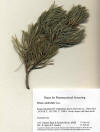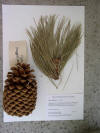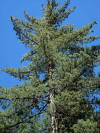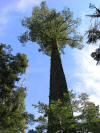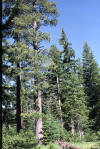|
Pinus cembroides
|
Pinus contorta ssp.
murrayana
|
Pinus contorta
ssp. contorta
|
|
Pinus contorta ssp.
murrayana
|
Pinus contorta ssp.
murrayana
|
Pinus edulis |
|
Pinus jeffreyi |
Pinus jeffreyi |
Pinus jeffreyi |
|
Cones and bark of Pinus jeffreyi and P. ponderosa. Cones of Pinus jeffreyi and P. ponderosa from the Kern Plateau, CA. CNPS camping trip 25–28 June 2015, collected from five sites (by Suzanne Weller and Richard Spjut), ranging in elevation from 6300–7300 ft. Two cones collected from each site, except one site represented by only one cone. Ponderosa pine in lower right corner, two cones 8–9 cm in length, collected at ~6300 ft as determined from review using Google Earth. All others Jeffrey pine, ranging in size from 9–13 cm in length, collected at four sites at different elevations, 6600–7300 ft. Images from Google search (6 Jul 2015) on Pinus jeffreyi bark and Pinus ponderosa bark. Bark appears variable in both species. |
||
|
Pinus lambertiana
|
Pinus monophylla
|
Pinus monophylla
|
|
Pinus monticola
|
Pinus monticola
|
Pinus monticola
|
Pinus ponderosa var.
pacifica |
Pinus ponderosa var.
pacifica |
Pinus radiata
|
|
Pinus sabiniana
|
Pinus sabiniana
|
Pinus sabiniana |
|
Trees and Shrubs of Kern County (Jan 2013, Dec 2013, July 2015) Key to Species of Pinus Needles 1(-2) to a bundle...................................................................... Pinus monophylla Needles 2 to a bundle............... ...................................... Pinus contorta ssp. murrayana Needles 3 to a bundle........................................................................................................ 2 Needles 5 to a bundle........................................................................................................ 6
2. Cones scales ending
in sharp triangular appendages that are strongly
2. Cone scales with
sharp needle-like to short triangular prickles arising 3. Leaves drooping; cones brown....................................................... Pinus sabiniana 3. Leaves spreading to erect; cones pale yellow............. ........................ Pinus coulteri 4. Cones closed............................................................................................... Pinus radiata 4. Cones open..................................................................................................................... 5
5.
Cones 9–25 cm in length;
scale prickle spine-like, usually incurved;
5.
Cones 8–18 cm; scales near scale prickle deltoid (triangular), outcurved;
6. Cones 7–15 cm;
branches and branchlets slightly to strongly
6. Cones 20–60 cm;
branches horizontal, branchlets often
Pinus contorta Douglas ex Loudon 1838 ssp. murrayana (Pinus murrayana Balfour 1853) Critchfield 1957. Lodgepole pine. Tree to 30 m or more, with distinctive bark of short flat overlapping scales; leaves in bundles of 2; 3–8 cm; cones relatively short, brown, between 4 and 5 cm long, about twice as long as wide, and widest in the mid region. Common in the upper drier montane forests in much of the western U.S.; in California mostly in the Sierra Nevada and Transverse Ranges. Lodgepole pine forest recognized in MCV2 when >5% absolute cover in the tree canopy with <5% absolute cover by other conifers, or >50% relative cover where it may share dominance with white-bark pine. Type from Siskiyou Mts., 7,500 ft. Kern Co.: A “colony at Pine Flat and another at Little Cannell Meadow, both on the southern end of the Kern Plateau and barely within Kern County. Pine Flat shows evidence of once having been a moist meadow that has rapidly dried in the past few decades and is now a sagebrush flat. As all of the lodgepoles here are mature, it is quite possible that the tree will eventually become extinct at this station” (Twisselmann), 2,165 m (CCH). Klamath Indians used pitch to treat sore eyes. Pinus coulteri D. Don 1837. Coulter pine. Tree to 25 m; bark brown with wavy short longitudinal fissures between the thick ridges; the branches often ascending, or wide spreading and ascending abruptly near ends; needles in bundles of 3, (15-) 20–30 cm; cones massive for their size, 25–35 cm, yellowish brown. Primarily found along the California coast mountains from Contra Costa Co to northern Baja California. Coulter pine woodland in MCV2 recognized when >30% relative cover in the tree canopy. Type from Santa Lucia Mts., CA. Not generally recognized in Kern County but several collections in CCH report it from the Tehachapi Mountains: Tehachapi Valley, SE of Tehachapi Willow Springs Rd; and 2.3 mi north of Oak Creek Rd, 1,524 m. Pinus flexilis James 1823. Limber pine. Tree with upward spreading to ascending branches, especially towards the ends of branches, some branchlets on a tree often totally erect; bark flaky or chunky reddish brown to gray brown; leaves in bundles of 5, often clustered at ends of branches, (2-) 5–9 cm long; cones hanging downwards from branches, yellowish brown, widest in the mid region or near base, tapering gradually to apex, not prickly. Timberline forests from the Rocky Mts. to the Sierra Nevada and south to Peninsular Ranges. Limber pine woodland recognized in MCV2 when dominant and >55% relative cover or >25% absolute cover in tree canopy. Type from Rocky Mts., CO. Kern Co.: Mt. Pinos and Sawmill Mt. (Twisselmann), 2,561–2,743 m (CCH). Pinus jeffreyi Balfour 1853. Jeffrey pine. Tree to 40 m or more; bark in flattened irregular diamond-shape plates, usually narrower than ponderosa pine, reportedly more distinct for its vanilla odor; leaves in bundles of 3, 12–27 cm; cones usually larger than ponderosa pine, (9-) 13–27 cm, the prickle underneath the scale usually incurved. Primarily a California species of the drier montane forests but mostly absent from the Central and South Coast Ranges, generally above the ponderosa pine belt, or along ridges. Jeffrey pine forest recognized in MCV2 when >5% absolute cover in the tree canopy with usually no more than 5% Lodgepole pine and white fir and some exception to red fir. Type from Shasta Valley, CA. Kern Co.: a dominant tree on the Kern Plateau, in the Greenhorn Range, Breckenridge Mts., Piute Mts., Tehachapi Mts., and Mt. Pinos, mostly above 6,000 ft (Twisselmann), 1,707–2,435 m (CCH). Jeffrey pine and ponderosa pine are usually distinguished by seed cone length, (9-) 13–25 cm long, in contrast to 7–12 (-15) cm for ponderosa pine. This may work well for plants in northern California. In southern California, P. ponderosa var. pacifica is described to have cones up to 18 cm in length, which therefore overlaps with Jeffrey pine. However, this overlap also occurs at the lower end of the cone size as observed for plants on the Kern Plateau in Tulare County between Horse Meadow Campground and the junction to the Sherman Pass Road where cones of Jeffrey pine at four sites at different elevations from 6600–7300 ft were within the range size of ponderosa pine, 9–13 cm long, while also observed to become shorter as one descends lower in elevation. They were distinguished as Jeffrey pine by the width of the scale at the base of the cone, consistently 2–2.5 cm wide, and by the incurved prickle. A fifth site at 6300 ft elev., at the lowest elevation of the mixed conifer forest region, had ponderosa pine, which was recognized by the relatively small cones, 8–9 cm in length with scales more widely separated and by the triangular-shaped outward pointing prickles; the largest scales (near base) were 1.5 cm in width. A review of CCH shows no records for ponderosa pine from the Kern Plateau, while only three collections were listed for Jeffrey pine. The inner bark of Jeffrey pine reportedly has a vanilla or pineapple odor, but scientific evidence to support distinction by smell is lacking; however, Schiff's reagent may be used to distinguish the species by a color reaction, deep purple for Jeffrey resin, which contains heptane, and no reaction for ponderosa resin, appearing clear yellowish due to the absence of heptane, containing, instead, terpenes as in most other species of pine. See Chester and Strong webpages (2014, last update Nov 2014) on distinguishing ponderosa and Jeffrey pines with reference to Haller (1962); they give a 70% reliability for the smell test. Pinus lambertiana Douglas 1827. Sugar pine. Tree to 60 m with brown longitudinally fissured bark, the chunks or plates short, narrow and wavy; leaves in bundles of 5, 5–10 cm; cones the largest of the Kern County species in length, 25–60 cm, not prickly but can be sticky (resinous). Primarily a California montane species extending into Oregon, western Nevada and Baja California. Sugar pine forest recognized in MCV2 when >30% relative cover in the tree layer. Type from headquarters of the Umpqua River, OR. Kern Co.: “Most common in the Greenhorn Range and on Breckenridge Mt, and in small groves on Piute Mountain, and north slope of Tehachapi Peak, also Tollgate Ridge east of Keene, southeast slope of Brush Mountain in the Mt. Pinos region, northeast ridge of Mt. Own near county lines with Inyo and Tulare” (Twisselmann), 1,400–2,260 m (CCH). Pinus monophylla Torrey & Fremont 1845. Pinyon pine. Tree with one or more trunks, often with a very broad rounded crown, not more than 15 m high; needles mostly 1; cones short, about as wide as long, 3–12 cm. Widely distributed in the western U.S. semi-desert regions. In California, common above the Joshua tree zone, usually associated with juniper. “Singleleaf pinyon woodlands” recognized when >5% absolute cover in tree canopy. Type locality not precisely known. Kern Co.: “Common, often forming distinct woodlands, on the desert slopes of the mountains wet to the Piute Mountains and the east slope of the Greenhorn Range and south-west to Ventura and Santa Barbara counties at the east end of Cuyama Valley” (Twisselmann), 1,220–2,043 m (CCH). “The nuts, often borne prolifically, are an important source of food for birds, mammals, and formerly the Indians (Twisselmann)” Pinus ponderosa Douglas ex Lawson & C. Lawson 1836. var. pacifica J.R. Haller & Vivrette 2011. Ponderosa pine. Tree with orange to brown bark, var. pacifica more yellowish than in other varieties outside the flora, the fissures often deep and wide between the flattened ridges or plates; needles 3 to a bundle, 15–28 cm; cones 8–18 cm. The species widely distributed. Ponderosa pine forest recognized in MCV2 when a principal canopy species >10% absolute cover, or 50% relative cover, which may include a low cover of hardwoods. Kern Co.: “The dominant tree of the yellow pine forest below 6,000 feet elevation in the Greenhorn Range and on Breckenridge Mountain where it forms an extensive and well developed forest. It does not occur in the Piute Mountains and survives only in scattered relict colonies in the Tehachapi Mountains and the Mt,. Pinos region (Tejon Canyon, Water Canyon, near Mil Portreros)” (Twisselmann), 1,280–2,133 (CCH). A mixed conifer forest is also recognized in MCV2 of ponderosa pine and incense cedar in >1% absolute cover in the tree canopy and/or regeneration layers with >60% relative cover in tree canopy. Ponderosa pine is generally distinguished from Jeffrey pine by its smaller size, <12 cm in the typical variety, up to 18 cm in var. pacifica, which therefore overlaps in size with Jeffrey pine, 13–25 cm long, the width appearing proportional to length. Intermediates then have to be separated by other character traits as discussed under Jeffrey pine. The other California varieties occur further north, var. ponderosa, from northern California to British Columbia and east to Montana; var. washoensis (H. Mason & Stockw.) J.R. Haller & Vivrette, which differs slightly by having brown instead of black on the scale underside, occurs from northern California and western Nevada to British Columbia. Pinus ponderosa var. pacifica is also recognized to occur further north in California, to southwestern Oregon and Washington where distinguished by the bark appearing light to medium yellow brown, in contrast to dark red or yellow brown in the other varieties. It should be noted that there are relatively few records for var. pacifica in CCH and Calflora. Considering the difficulty in distinguishing ponderosa pine from Jeffrey pine, and that bark is required to differentiate the varieties of ponderosa pine, which is usually not collected for the herbarium, and that both Jeffrey pine and ponderosa pine appear variable in bark morphology—as seen by images on Google search—this would account for the lack of herbarium record determinations to variety for the ponderosa pine. *Pinus radiata D. Don 1836. Monterey pine. Tree to 35+ m; bark narrowly ridged, inner resinous; needles in 3's, 10-15 cm long, persisting ~3 yrs; cones 7.5-14 cm long. Kern Co. Tehachapi Mts., above Bear Valley Springs. Presumed to have been planted. Monterey pine planted as ornamentals comes from New Zealand stock. This stock originated from native California populations several generations ago. In Cambria and Monterey, California, this imported stock is crossbreeding with native individuals. The genetic effects of this crossbreeding on native trees is unknown, and preserving genotypes of native individuals is a point of management concern [39]. Monterey pine is the subject of a genetic conservation program [27]. Pinus sabiniana Douglas 1832. Ghost pine, gray pine, digger pine. Tree to 25 m with gray irregularly fissured bark; leaves grayish green, in bundles of 3, 20–40 cm; cones persistent on trees, massive in density, 15–25 cm, with thick scales that bear sharp curved claws at ends. A common woodland species of California away from the coast. Ghost pine woodland recognized in MCV2 when dominant and >10% absolute cover. Type: near San Juan?, CA] Kern Co.: Common in canyons in Kern County west of the desert and east of valley. “Grows in a belt primarily below 4,000 ft and always below the permanent winter snow line, preferring hot dry canyons and ridges with rocky or thin soil. In Kern County, however, digger pine occurs to at least 6,000 feet on the east slope of Piute Mountain and on the east slope of the Greenhorn Range; in these places the tree grows with Jeffrey and ponderosa pine and becomes a well developed forest tree that little resembles the typical straggly foothill form. It approaches the desert in Sand and Cameron canyons in the Tehachapi mountains and occurs at the heads of the very arid desert canyons north of Walker Pass to the summit of Nine Mile Canyon in Inyo County. Here digger pine often grows as scattered and even isolated individuals in the well developed pinyon woodland of the region. At Lamont Meadow, just north of the Kern County line, digger pines and western junipers (Juniperus occidentalis) often grow together; these trees ordinarily occur several life zones apart” (Twisselmann), 610–2,073 m (CCH).
|
||
